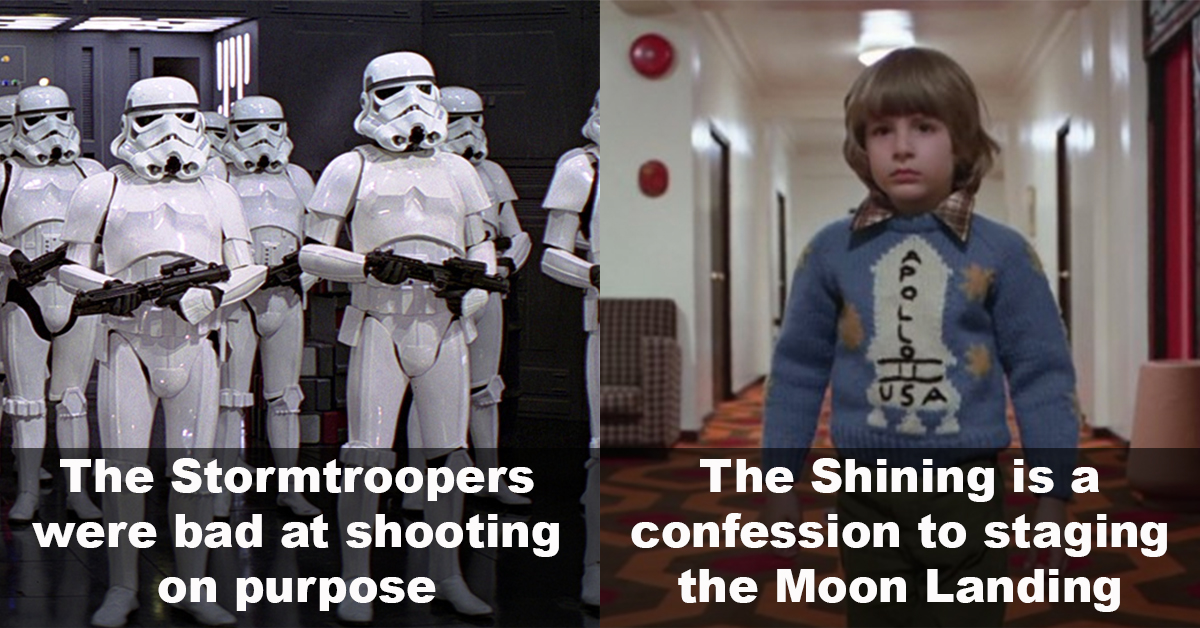The 1980s were chock-full of original blockbusters made for as wide an audience as possible; this, truly, was the age of the great family film. The 80s was, perhaps, the greatest era there’s ever been for popular entertainment on the silver screen, leaving with us a legacy that fans of all ages have been obsessing over ever since.

It’s for this reason that so many 80s movies have been the subject of so many fan theories – some brilliant, some nonsensical, and some that are, simply, downright bizarre. 80s movies endure for a wide range of film fans, and so too does the speculation over what these movies are all secretly about.
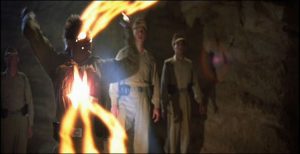
Here are the 14 most bizarre (and, on occasion, 100% believable) 80s movie fan theories.
14. Stormtroopers are bad shots for a reason in the Star Wars movies

In the original Star Wars trilogy, the Empire’s common ground soldiers, the stormtroopers, are famously bad at shooting. Most have brushed this off as a typical movie trope – we need our heroes to survive, after all – as it doesn’t make much sense that the galactic supersoldiers would have poor aim. Stormtroopers are bred for fighting, and trained as crack soldiers from an early age. In A New Hope, Obi-Wan Kenobi even tells our heroes that stormtroopers are “precise” crack shooters.
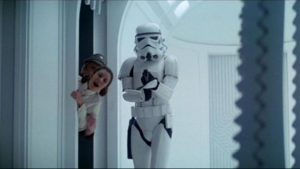
What if stormtroopers aren’t totally incompetent when it comes to using their laser rifles, but are in fact just faking it? In certain moments, like the attack aboard the Tantive IV or in the battle of Endor, stormtroopers are expert shots. The only time they seem to be going easy on our protagonists is when Darth Vader’s ultimate plan is seemingly to leave them alive and lure them to him.
13. MacReady passes Childs a Molotov cocktail at the end of The Thing
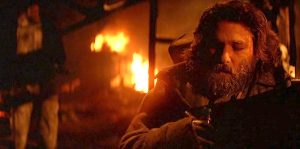
The Thing, John Carpenter’s 1982 classic of isolation-horror and Reagan-era paranoia, might have one of the best ambiguous endings of all time. After the rest of the crew at the Antarctic base have been wiped out one by one by the titular shapeshifting alien, sole survivors MacReady and Childs apprehensively share a drink, neither trusting that the other isn’t secretly “one of those things”.
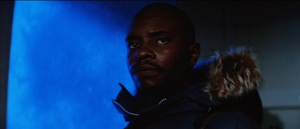
Some fans of the film, however, think MacReady is onto his companion, and isn’t passing Childs an alcoholic drink at the end of the film at all. One theory is that the ‘booze’ is actually a bottle of Molotov cocktail as seen earlier in the film. As Childs takes a swig without complaint, and MacReady snickers in response, has MacReady just unveiled ‘Childs’ as another thing?
12. Who Framed Roger Rabbit’s Judge Doom is actually the Pistol Packin’ Possum

At the somewhat nightmarish climax of Who Framed Roger Rabbit, it’s revealed via the medium of steamroller that antagonist Judge Doom is actually a toon himself, now disguised as a human. The film doesn’t give us Doom’s former identity before he’s despatched by Eddie Valiant, but fans of the film think they have it pretty well down.
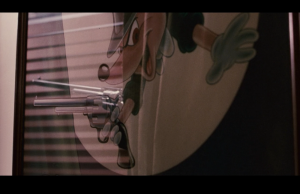
Clues throughout Roger Rabbit suggest that Doom was actually The Pistol Packin’ Possum, an obscure character from a forgotten, 1946 animated short. (Which might explain why ‘Judge Doom’ is so angry: surrounded by famous toons, he’d be right to be jealous.) A poster for Possum appears in one scene, while Doom like that rascally character has red eyes – the only cartoon part of him we get to see – and the character’s same cartoon gun.
11. Indiana Jones could have prevented WWII
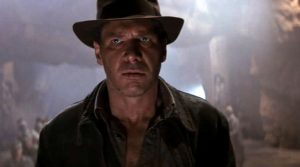
“Would you feel more comfortable opening the Ark in Berlin, for your Fuhrer?” Belloq asks of Colonel Dietrich towards the end of Raiders of the Lost Ark, prior to testing his ancient artefact out on the Mediterranean island. This line suggests that the intention all along was to get the Ark before Hitler, for the Nazi leader himself to open it, at which point he – and presumably members of the Nazi high command – would have been wiped out.
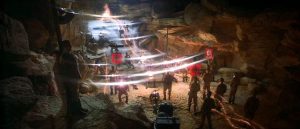
So what if Indy hadn’t put the Ark in storage, and had instead allowed the Ark back into Nazi hands, giving it safe passage back to Hitler himself? Raiders takes place in 1936, meaning Indiana Jones could have brought down the Third Reich and prevented WWII from ever happening.
10. RoboCop is Jesus
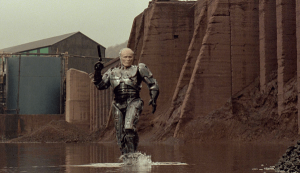
It’s not exactly a faithful retelling, but RoboCop could be an adaptation of the story of Christ, albeit an incredibly R-rated one. Think about it: good cop Alex Murphy is ‘sacrificed’ for the sins of man (the criminals of Detroit in this take), then is resurrected by a god – technology – as RoboCop, coming back stronger than ever.

Director Paul Verhoeven has spoken at length about the intentional parallels between Alex Murphy’s story and the myth of Christ, confirming the theory as fact for some fans. We see it in the way Murphy is killed – brutally, with his hand being shot through, crucified with a bullet rather than a nail – and the scene wherein RoboCop, passing through wet ground, appears to actually walk on water.
9. Doc Brown was just trying to kill himself
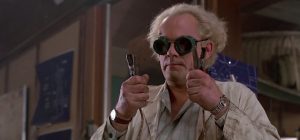
What if Doc Brown was suicidal and didn’t actually know the DeLorean was going to disappear through his legs rather than hit him? That’s the Back to the Future theory put forward by some fans, who believe that Doc, who admits to being depressed, wants to go out his own way: killed by one of his inventions when this one inevitably doesn’t work either.
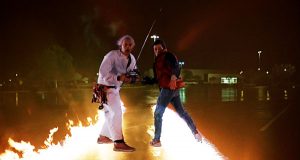
It’s not a plot point that’s exactly appropriate for a fun piece of family entertainment, so either the producers filmed then scrapped references to it – as they did with original Marty McFly actor Eric Stoltz – or it’s just another fan theory that was never considered by the film’s authors in the first place. Either way, the theory does in a slightly perverse way make the film even sweeter: Doc, formerly suicidal, makes the decision to live only after spending quality time bonding with his grandson.
8. Terminator is modelled on Predator’s Dutch

The Alien Vs Predator movies already confirmed that Predator shares a movie universe with another film, so who’s to say this same universe doesn’t have room for a third film? Some fans believe specifically that the Predator universe also takes place in the world of The Terminator, with Predator protagonist Dutch serving as a model for the 1984 film’s robotic killing machine, the T-800.
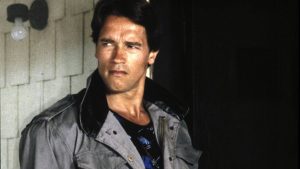
The evidence? Well, Dutch and the T-800 look and sound distinctly identical – who else in the world could look and sound like that? – while a cyborg Dutch appeared in a 1994 Alien vs Predator game, with a serial number referencing Terminator’s Cyberdyne Systems. Plus, it would make sense that future designers of the T-800 tech would use the resourceful man who took down the Predator as their model for a formidable assassin.
7. Daniel is the real bully in The Karate Kid

Considering he’s the film’s hero, The Karate Kid‘s Daniel doesn’t act all that heroically. His rival Johnny, meanwhile, spends the film trying to become a better man, as the violent, reactionary Daniel steals Johnny’s girlfriend and continually goes out of his way to antagonise Johnny and the Cobra Kai. It’s for this reason that fans believe Daniel is in fact the real bully in The Karate Kid.
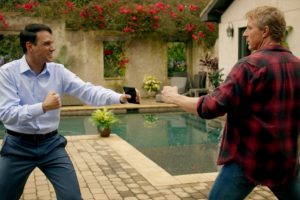
The new Karate Kid spin-off series, Cobra Kai, seems to acknowledge and just maybe even confirm the fan theory. In the show, Johnny is now the main protagonist, a down-on-his-luck middle-aged guy turning his life around by training local teens in the art of karate. Daniel, true to form, wants to put a stop to this – no good deed, it seems, will happen on his watch.
6. Labyrinth’s goblins are all babies kidnapped and transformed by Jareth
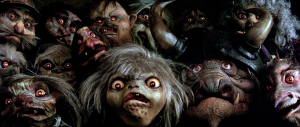
David Bowie’s codpiece is disturbing enough, but did you hear about the fan theory regarding Bowie’s villain Jareth that makes fantasy classic Labyrinth seem even creepier? It’s never entirely clear in the film why Goblin King Jareth steals a baby to tempt its 15-year-old sibling, played by Jennifer Connelly, into his lair – unless you believe the somewhat out-there hypothesis that Jareth has actually been at this game for a very long time.
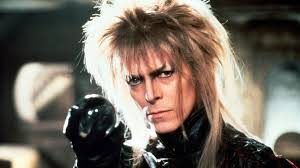
The theory goes that Jareth has for years been seeking young women that remind him of a long lost love, always kidnapping a child relation to lure the girls to him. When these girls don’t make it to Jareth through his labyrinth, he gives up on them and turns the baby into a goblin – meaning his odd-looking, infantile goblin army is actually made up of all the many babies he’s captured and transformed over the years.
5. Crossing the streams killed the Ghostbusters

We’re informed by Egon Spengler at the beginning of Ghostbusters that crossing the streams, or joining the energy beams from the ghost-trapping proton packs the team wield, would be very unwise (“try to imagine all life as you know it stopping instantaneously and every molecule in your body exploding at the speed of light”). At the end of Ghostbusters, though streams are indeed crossed, everyone seems to survive to celebrate the day.
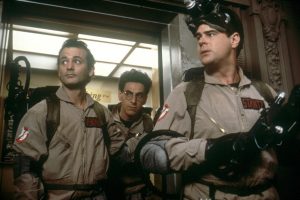
That is unless they all died right then and there – the natural scientific outcome of crossing the streams – and the rest of the film is their dying fantasy. There was a sequel to the first Ghostbusters film, of course, but theorists have an explanation for that too. Ghostbusters II, as critics at the time pointed out, isn’t much more than a replay of the first movie, but the reason for that may be that the team are all in purgatory, experiencing the events of the first Ghostbusters all over again.
4. Deckard’s memories are Gaff’s in Blade Runner
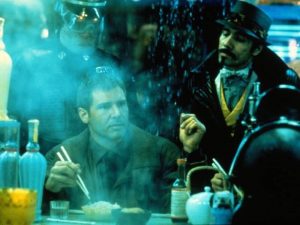
What could be the reason for Gaff’s antagonistic relationship with Deckard? Why does Deckard seem cowed in Gaff’s presence, while Gaff seems mockingly superior, even toying with Deckard throughout the course of the film? Could it simply be that Gaff, as LAPD, looks down on Deckard’s chosen profession of android hitman?

Or could it be – as some fans have speculated – that Deckard is actually a replicant (something since confirmed by Ridley Scott) with Gaff’s memories implanted? It would at least explain the pair’s mysterious apparent psychic connection, Gaff through his origami figures showing he knows exactly how Deckard feels at a given time and even what he dreams of, as well as Gaff’s curious fascination with and distaste for Deckard.
3. Ferris Bueller isn’t real
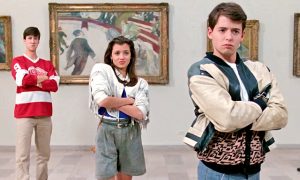
A theory that changes Ferris Bueller’s Day Off from a John Hughes teen comedy into Fight Club minus the underground brawling, the speculation that Ferris Bueller never actually existed except in Cameron’s mind has been long-running. It’s likely not what Hughes intended, but the ‘evidence’ still piles intriguingly high.

The nervy, introverted Cameron would never bunk off school willingly – but his imaginary ‘best friend’, the confident and uninhibited Ferris, would. Ferris would spend Cameron’s day in bed – where Cameron actually is the entire film, according to the theory, genuinely ill and dreaming of a day in which he’d rebel against his domineering father – living the high life, driving fancy cars and eating expensively.
2. ET is a lost Jedi
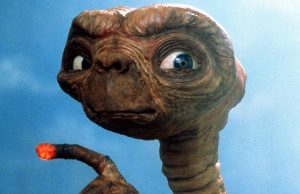
Keep an eye out during the senate scene in Star Wars Episode I: The Phantom Menace and you’ll see what amounts to almost a confirmation of this theory. As Chancellor Valorum is deposed, in the bottom left of the screen on one of the platforms can be seen three of whatever species ET is – meaning ET exists in the Star Wars universe, and that in Spielberg’s alien classic he may well be displaying his prowess as a Jedi.

The theory would explain ET’s magical powers, all of which happen to also be specialities of the Jedi: the ability to move objects using only power of the mind, the ability to make a psychic connection with others and, debatably, using mind control (is ET using a Jedi mind trick on Mary when she fails to see him amid Gertie’s stuffed animals?). The fact that ET can also bring the living back from the dead – a plant, but even so – would mean he’s an especially powerful member of the Jedi order.
1. The Shining is Kubrick’s confession to staging the Moon landing
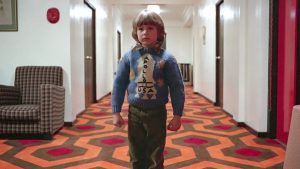
Thanks to its mysterious, occasionally impenetrable nature, Stanley Kubrick’s 1980 horror masterpiece The Shining has been the subject of countless fan theories since its release. Have you heard the one about how the Overlook Hotel is actually a manifestation of Hell? Or that the whole film is about CIA mind control?
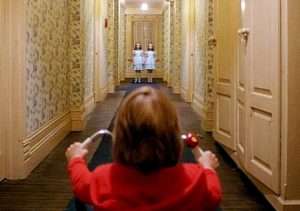
Inarguably the best bizarre theory regarding The Shining brings into play another enduring conspiracy theory. It’s long been speculated that the Moon landings were faked, but The Shining according to some is Stanley Kubrick’s confession to, and apology for, being the director behind the staging himself. Proponents of this theory point to Danny’s Apollo 11 jumper, the ghostly twins (apparently a reference to the Gemini space programme) and much more that, to the rest of us, seems entirely coincidental.

